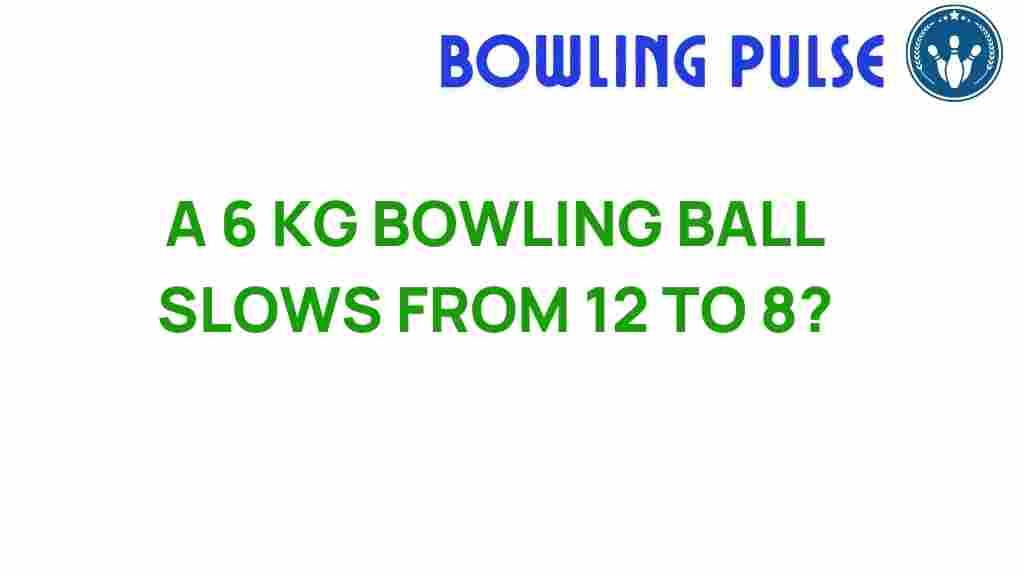Understanding Bowling Physics: The Dynamics of a 6 KG Bowling Ball
Bowling is not just a leisure activity; it is a fascinating interplay of physics, ball dynamics, and sports science. When you roll a 6 kg bowling ball, various forces and principles come into play that determine how the ball behaves on the lane. In this article, we will explore the physics behind a 6 kg bowling ball’s dramatic slowdown, focusing on velocity loss, momentum, and the techniques that can improve bowling performance.
The Basics of Bowling Physics
At its core, bowling is governed by fundamental physical principles. When you release a bowling ball, several factors impact its motion:
- Mass and Weight: The mass of the bowling ball (6 kg in this case) affects its inertia and how it interacts with other objects.
- Velocity: The speed at which the ball is thrown significantly influences its momentum.
- Friction: The interaction between the ball and the lane surface plays a crucial role in its deceleration.
- Spin: The way the bowler spins the ball can alter its trajectory and interaction with the pins.
Understanding these elements will help bowlers enhance their techniques and improve their overall game.
Momentum and Velocity Loss
Momentum is defined as the product of mass and velocity (p = mv). In the case of a 6 kg bowling ball, the momentum at the moment of release is critical. However, as the ball travels down the lane, it experiences various forces that contribute to its velocity loss:
- Friction with the Lane: As the ball rolls, it encounters friction with the lane surface, which gradually slows it down.
- Air Resistance: The ball also experiences drag from the air, which can affect its velocity, especially over longer distances.
- Impact with Pins: Upon hitting the pins, the ball transfers some of its momentum to them, which can lead to a further reduction in speed.
These factors combined lead to a dramatic slowdown of the bowling ball as it progresses down the lane.
Bowling Techniques to Maintain Velocity
To enhance bowling performance and minimize velocity loss, certain techniques can be employed:
- Proper Grip: Ensuring a comfortable grip on the ball helps maintain control and allows for a smooth release, reducing unnecessary friction.
- Release Timing: Timing the release properly can optimize the ball’s speed and trajectory.
- Follow-Through: A good follow-through helps in maintaining momentum and ensuring that the ball continues to roll smoothly.
- Spin Technique: Adding spin can help the ball hook into the pins but requires practice to master for effective velocity management.
Incorporating these techniques into your game can significantly enhance your bowling score and overall experience.
Analyzing the Slow Motion of a 6 KG Bowling Ball
When observing a 6 kg bowling ball in slow motion, one can witness the intricate details of its dynamics:
- Initial Release: The ball starts with a high velocity as it leaves the bowler’s hand.
- Rolling Motion: The transition from sliding to rolling motion is critical, as it determines how friction affects the ball.
- Impact with Pins: The moment of impact showcases the transfer of momentum and the resulting velocity loss.
This analysis not only helps bowlers understand their performance but also provides insights into the underlying physics that govern the sport.
Step-by-Step Process of Bowling Performance Improvement
Improving your bowling performance requires a systematic approach:
- Assess Your Current Technique: Record your bowling sessions to identify areas that need improvement.
- Analyze Your Grip and Release: Pay attention to how you hold and release the ball. Adjust your grip for better control.
- Practice Your Follow-Through: Focus on a consistent follow-through to ensure the ball maintains its velocity.
- Work on Your Spin: Experiment with different spins to find what works best for your style and the lane conditions.
- Utilize Slow Motion Analysis: Use slow-motion video analysis to observe your technique and make necessary adjustments.
By following these steps, bowlers can systematically enhance their skills and improve their performance on the lanes.
Troubleshooting Common Issues
Even the most seasoned bowlers encounter challenges. Here are some common issues and solutions:
- Issue: Inconsistent Release
Solution: Focus on your grip and practice a smooth release to improve consistency. - Issue: Excessive Spin or Hook
Solution: Adjust your grip and release point to control the spin better. - Issue: Poor Pin Action
Solution: Ensure you are hitting the pocket correctly; adjust your angle and speed as needed.
Identifying and addressing these issues can lead to significant improvements in your bowling performance.
Conclusion: Mastering the Physics of Bowling
Bowling is a complex sport that intricately combines bowling physics, ball dynamics, and sports science. Understanding how a 6 kg bowling ball behaves on the lane can help bowlers manage velocity loss and enhance their performance. By employing the right techniques and analyzing their movements, bowlers can achieve a deeper understanding of their game.
Whether you are a beginner or a seasoned player, mastering the physics behind bowling can lead to improved scores and a more enjoyable experience on the lanes. For more insights into improving your bowling techniques, check out this helpful resource. Remember, the more you understand the principles of momentum and velocity in bowling, the better your performance will be!
Ready to take your bowling game to the next level? Start practicing today and witness the remarkable effects of physics on your performance!
This article is in the category Techniques and created by BowlingPulse Team
